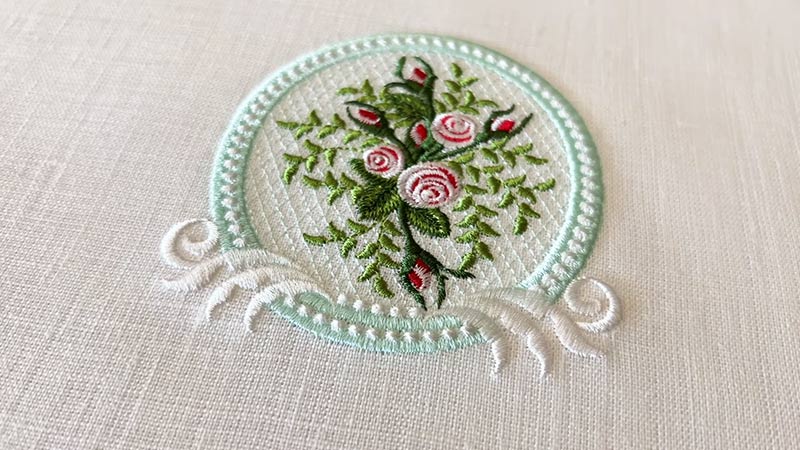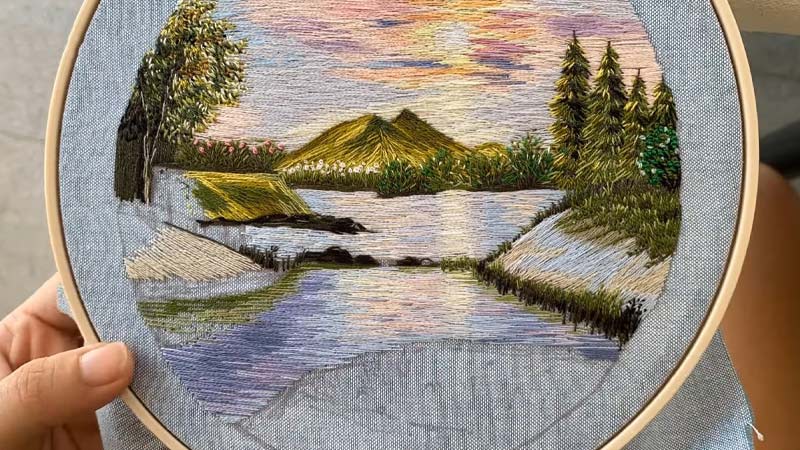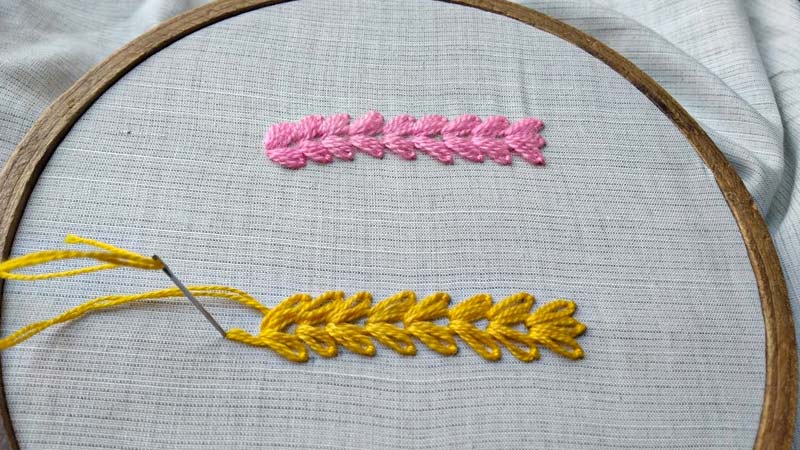In the vast tapestry of artistic history, the Renaissance stands as a beacon of cultural rebirth and innovation.
Among the myriad forms of expression that flourished during this period, Renaissance embroidery emerged as a delicate and intricate art form transcending mere needle and thread.
This exquisite craft not only adorned the garments of the elite but also wove a narrative of skill, creativity, and societal nuances. Join us on a journey through the threads of time as we explore what is Renaissance embroidery.
From the opulent courts of Europe to the bustling workshops of skilled artisans, this exploration will unravel the secrets behind the stitches, shedding light on the techniques, motifs, and cultural influences that shaped this timeless art.
Discover the interplay of craftsmanship and creativity that transformed fabric into a canvas for expression, leaving an indelible mark on the legacy of textile arts.

What Is Renaissance Embroidery?
The Renaissance, a period of cultural and artistic flourishing spanning the 14th to the 17th century, was marked by a revival of classical ideals and a surge in creativity across various domains.
It is the art or process of sewing and forming decorative designs with hand or machine needlework. In the midst of this cultural rebirth, the art of embroidery evolved into a refined and intricate craft, creating a legacy that continues to captivate enthusiasts and historians alike.
Historical Context Embroidery in the Renaissance
Embroidery has a long history, but it was during the Renaissance that it truly came into its own. The period was characterized by a fascination with beauty, aesthetics, and the revival of classical forms.
Embroidery became an essential element in the world of fashion, interior decoration, and religious artifacts.
Artisans during the Renaissance approached embroidery with a newfound appreciation for detail and precision.
Techniques and Materials: The Art of the Needle
Renaissance embroidery encompassed a variety of techniques, each requiring a skilled hand and an artistic eye. One of the most prevalent Renaissance embroidery patterns was “couching,” where threads were laid on the fabric and secured with small stitches.
This method created intricate patterns and raised surfaces, adding depth to the embroidered piece.
Motifs and Themes Symbolism Woven in Thread

Renaissance embroidery was not merely about aesthetics but a language of symbols and meanings woven into fabric.
Religious motifs were prevalent, with scenes from biblical narratives and depictions of saints adorning ecclesiastical garments and textiles.
The intricate detailing in these religious embroideries elevates the spiritual experience and underscores the reverence associated with the Church.
Regional Influences: A Tapestry of Diversity
The art of Renaissance embroidery was not confined to a specific region or style. Different European regions developed their unique approaches, influenced by cultural, social, and economic factors.
Italian embroidery, for instance, was characterized by its finesse and elegance. Venetian embroiderers were renowned for using delicate medieval embroidery stitches and rich color palettes, while the Florentines excelled in creating intricate floral motifs.
Legacy and Contemporary Reverence
The legacy of Renaissance embroidery endures, inspiring contemporary artisans and designers. Museums and historical collections house exquisite examples of embroidered textiles from the Renaissance, showcasing the skill and artistry of the craftsmen who worked diligently to create these masterpieces.
Today, embroidery enthusiasts and historians alike continue to study and appreciate the techniques and motifs of Renaissance embroidery.
What Are Some Easy Renaissance Embroidery Patterns?

Embarking on a journey into the world of Renaissance embroidery can be a delightful experience, especially for those new to the art of needlework.
While the intricate masterpieces of the Renaissance era may seem daunting, there are several easy and beginner-friendly patterns that capture the essence of this rich artistic tradition.
These patterns provide a great starting point for learning basic embroidery techniques while creating beautiful and historically inspired pieces.
Simple Floral Motifs
Pattern Description Floral motifs were a common theme in Renaissance embroidery, symbolizing beauty and nature. Start with a simple flower pattern, like a Tudor rose or a stylized lily, and experiment with basic stitches such as satin or stem stitch.
With your Renaissance embroidery machine, these motifs can be embroidered onto small items like handkerchiefs, cuffs, or pouches.
Geometric Blackwork Designs
Pattern Description Blackwork embroidery, characterized by repeating geometric patterns in black thread, gained popularity during the Renaissance.
Create easy blackwork patterns using basic geometric shapes like squares, triangles, or diamonds.
The simplicity of these designs allows beginners to focus on perfecting stitches like the backstitch while achieving a striking visual impact.
Initials and Monograms
Pattern Description Personalized embroidery, including initials and monograms, was common during the Renaissance. Choose a stylized font and embroider your initials or those of a loved one onto a fabric of your choice.
Practice the split stitch or chain stitch to outline the letters, adding a touch of personalized elegance to your embroidery.
Animal Motifs
Pattern Description: real and mythical animals often appeared in Renaissance embroidery. Opt for simple animal motifs like birds, rabbits, or fantastical creatures.
Use basic stitches like the running or satin stitch to outline and fill in the shapes. These charming patterns are perfect for adding a whimsical touch to small embroidery projects.
Celtic Knotwork Embroidery
Pattern Description While not exclusive to the Renaissance, Celtic knotwork shares aesthetic similarities with the era. Create simplified Celtic knot patterns that feature interwoven lines and loops.
Practice the stem stitch or the outline stitch to follow the intricate paths of the knotwork. These patterns are versatile and can be adapted for various embroidery projects.
Fleurdelis Embellishments
Pattern Description The fleur-de-lis, a stylized lily, was popular in Renaissance heraldry and design. Choose a straightforward fleur-de-lis pattern and experiment with stitches like the satin stitch for filling and the backstitch for outlining.
This motif works well on items like bookmarks and small bags or as an accent on clothing.
Simple Border Designs
Pattern Description Borders featuring repeating patterns were a common element in Renaissance textiles. Select a basic border design, such as a meandering vine or a geometric pattern, and practice the running or backstitch to create the outline.
What Are Some Other Popular Medieval Embroidery Stitches?
Medieval embroidery, spanning from the 5th to the 15th century, featured a rich tapestry of stitches that adorned everything from ecclesiastical garments to everyday textiles.
The artistry of medieval needlework has left an indelible mark on the history of embroidery, with various stitches reflecting the craftsmanship and creativity of the time.
Here are some popular medieval embroidery stitches that enthusiasts can explore:
Chain Stitch

Description The chain stitch is a fundamental medieval embroidery stitch that involves creating a series of interlocking loops. It can be used for outlining shapes, creating decorative borders, or filling in large areas.
The chain stitch provides a textured and raised effect, adding depth to embroidered designs.
Split Stitch
Description Widely employed in medieval embroidery, the split stitch is characterized by a continuous line of tiny, closely spaced stitches.
This stitch is ideal for creating fine outlines and intricate details, often used in religious motifs and manuscript illuminations. The split stitch produces a solid line that gives the embroidery a smooth and refined appearance.
Bayeux Stitch (Opus Anglicanum)
Description The Bayeux Stitch, also known as Opus Anglicanum, is a distinctive technique characterized by a combination of split stitches and couching.
Originating from the Bayeux Tapestry, this stitch is renowned for its use in depicting detailed scenes and narrative storytelling.
It allows for intricate shading and fine details, making it a favored choice for historical recreations.
Long-Armed Cross Stitch
Description This stitch is a cross-stitch variation commonly used in medieval embroidery. It involves creating longer arms in the cross shape, producing a bolder and more geometric effect.
Long-armed cross stitch was often employed in creating decorative borders and embellishing garments, providing a visually striking element to the embroidery.
Couched Work
Description Couching involves securing laid threads to the fabric using small stitches, creating intricate patterns and designs. Couched work was commonly used with metallic threads and added a touch of opulence to medieval embroidery.
Goldwork, in particular, often utilized couching to affix gold and silver threads onto textiles, showcasing the wealth and status of the wearer.
Seed Stitch
Description The seed stitch, or the speckling or seeding stitch, involves scattering small, random stitches across a surface to create a textured effect.
In medieval embroidery, the seed stitch was used for filling backgrounds, adding subtle nuances to the design. This stitch is versatile and can be adapted for both fine details and broader areas.
Herringbone Stitch
Description The herringbone stitch is characterized by a series of slanting stitches that create a V-shaped pattern. This stitch was often used in medieval embroidery for decorative borders and bands.
The herringbone stitch provides a structured and visually appealing texture, making it suitable for embellishing garments and textiles.
Feather Stitch
Description The feather stitch resembles a series of open V shapes and was commonly used in medieval embroidery for creating decorative lines and borders.
This versatile stitch can be adapted to various designs, lending a sense of movement and fluidity to the embroidered motifs.
FAQs
What distinguished Renaissance embroidery from earlier styles?
Renaissance embroidery departed from the simplicity of earlier styles, showcasing a newfound emphasis on intricate detail and symbolic depth.
Were there specific symbols or motifs commonly used in Renaissance embroidery?
Yes, Renaissance embroidery featured a rich array of symbols and motifs. Religious themes, including biblical narratives and depictions of saints, were prevalent. Nature-inspired motifs like flowers and animals were common, often carrying allegorical meanings.
How did regional influences shape the style of Renaissance embroidery?
Different European regions developed unique styles influenced by cultural, social, and economic factors. Italian embroidery, known for finesse, featured delicate stitches and rich colors.
Did Renaissance embroidery extend beyond clothing to other forms of art and decoration?
Absolutely. Renaissance embroidery extended its influence beyond clothing to ecclesiastical garments, religious textiles, and even portraiture. The art form adorned items such as tapestries, cushions, and accessories.
How has Renaissance embroidery influenced contemporary art and fashion?
The legacy of Renaissance embroidery continues to inspire contemporary artisans and designers. Modern fashion often incorporates elements reminiscent of Renaissance embroidery, with designers drawing inspiration from the intricate stitches and luxurious materials.
Conclusion
Renaissance embroidery is a testament to the meticulous craftsmanship and artistic fervor that defined an era of cultural resurgence.
The delicate intertwining of threads embellished garments and woven stories of societal values, individual creativity, and the pursuit of beauty.
As we unravel the intricacies of this timeless art form, it becomes clear that Renaissance embroidery transcends mere decoration. It is a living legacy that has endured for centuries.
The legacy of Renaissance embroidery continues to inspire contemporary artisans, preserving a connection to the past while fostering new expressions of creativity.
In its delicate stitches, we find a reflection of the Renaissance’s aspirations, dreams, and cultural dynamics.
As we appreciate the beauty of these meticulously crafted textiles, we are reminded that the art of embroidery is more than a decorative embellishment. It is a language that communicates the essence of a bygone era.
Leave a Reply